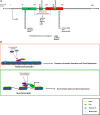Epigenetics, autism spectrum, and neurodevelopmental disorders
- PMID: 24104594
- PMCID: PMC3805864
- DOI: 10.1007/s13311-013-0227-0
Epigenetics, autism spectrum, and neurodevelopmental disorders
Abstract
Epigenetic marks are modifications of DNA and histones. They are considered to be permanent within a single cell during development, and are heritable across cell division. Programming of neurons through epigenetic mechanisms is believed to be critical in neural development. Disruption or alteration in this process causes an array of neurodevelopmental disorders, including autism spectrum disorders (ASDs). Recent studies have provided evidence for an altered epigenetic landscape in ASDs and demonstrated the central role of epigenetic mechanisms in their pathogenesis. Many of the genes linked to the ASDs encode proteins that are involved in transcriptional regulation and chromatin remodeling. In this review we highlight selected neurodevelopmental disorders in which epigenetic dysregulation plays an important role. These include Rett syndrome, fragile X syndrome, Prader-Willi syndrome, Angelman syndrome, and Kabuki syndrome. For each of these disorders, we discuss how advances in our understanding of epigenetic mechanisms may lead to novel therapeutic approaches.
Figures



References
-
- Kanner L. Autistic disturbances of affective contact. Nervous Child. 1943;2:217–250. - PubMed
-
- Autism and Developmental Disabilities Monitoring Network Surveillance Year 2008 Principal Investigators; Centers for Disease Control and Prevention. Prevalence of autism spectrum disorders—Autism and Developmental Disabilities Monitoring Network, 14 sites, United States, 2008. MMWR Surveill Summ 2012;30:61:1–19. - PubMed
-
- Brugha TS, McManus S, Bankart J, et al. Epidemiology of autism spectrum disorders in adults in the community in England. Arch Gen Psychiatry. 2011;68:459–465. - PubMed
-
- Geschwind DH, Levitt P. Autism spectrum disorders: developmental disconnection syndromes. Curr Opin Neurobiol. 2007;17:103–111. - PubMed
Publication types
MeSH terms
Substances
Supplementary concepts
Grants and funding
LinkOut - more resources
Full Text Sources
Other Literature Sources
Medical

